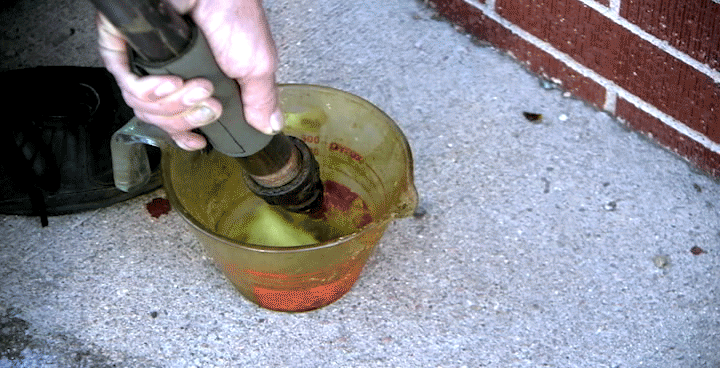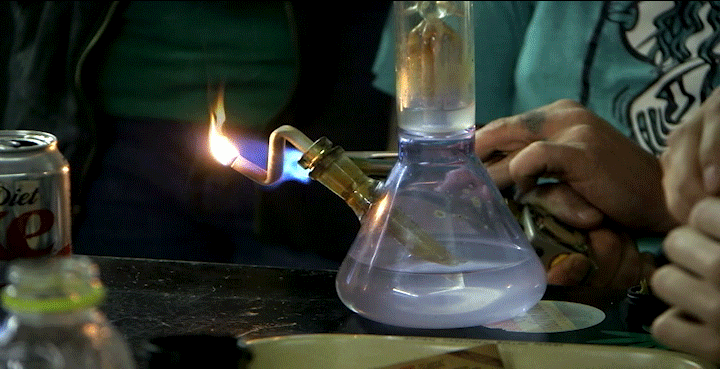For marijuana enthusiasts in Colorado, 420, a common nickname for pot, is old news. The new code number is 710. Flip the digits upside down and you get “oil,” a reference to oil-based cannabis concentrates. This wildly potent waxlike substance is one of the fastest growing segments of the marijuana industry.
The psychoactive component in pot is tetrahydrocannabinol, or THC. The THC content of pot has been steadily rising for decades, from about 3.5 percent in 1985 to 13 percent today. But these new concentrates can reach a staggering 90 percent THC. The high from smoking them, or dabbing, is so intense, High Times magazine called it a "quantum leap forward" in getting stoned. Concentrates are worth more per gram than gold.
That dizzying concentration also means a higher risk of addiction. Cannabis isn't usually associated with physical dependency. But Denver's only burn unit is seeing a rising number of patients burned in dabbing-related explosions, and many of them appear to be in the throes of withdrawal.

Concentrates — known as dabs, honey, shatter, budder and wax — are made through different extraction methods. Colorado’s retail marijuana industry can manufacture them safely by using expensive, commercially engineered equipment, but a rising number of amateur cooks are trying to make concentrates at home by watching how-to videos on YouTube. Home cooks typically use butane, a cheap and highly combustible solvent, and sometimes it explodes.
Since recreational pot use was legalized in Colorado a year ago, the number of explosions at home THC extraction labs has more than doubled, to 32, according to Kevin Wong, an intelligence analyst at the Rocky Mountain High Intensity Drug Trafficking Area, who tracks the impact of marijuana legalization in four states. And while a few cities like Denver have recently enacted ordinances against home THC extraction, in most places in the state it's still perfectly legal.
“The THC extraction labs are as dangerous, as explosive, as popular [as] — if not more so than — meth labs now,” said Wong.
Odorless and heavier than air, butane gas can linger along the floor and in corners of a room for long periods. Even a spark from static electricity is enough to cause an explosion.
“The volatile solvent is venting out into the atmosphere, usually inside a home because it’s cold outside, that’s where they have their laboratory,” said Wong, “And any source of ignition — be it a cellphone, a computer, a pilot light — that volatile gas will find it, and it will ignite.”
Kevin Wong
marijuana legalization analyst
In Denver the most severely injured burn victims end up at the University of Colorado Hospital, which runs the city’s only burn unit. In the past year, it has seen 17 patients admitted for marijuana-related burns. Some cases involved burns to more than 70 percent of the body and required extensive skin grafting.
“I didn't know about extracting THC out of marijuana using organic solvents,” said Gordon Lindberg, the burn unit’s medical director. “And I didn't know how easy it was. I mean, butane — it's what you get in cigarette lighters.”
Lindberg quickly noticed that there was something different about some of his new burn patients. They were nauseated and vomiting, which isn't characteristic of the injury. Managing their pain, he said, was a nightmare.
“The first few patients that came in, we were giving them the narcotics that we usually use and giving them fentanyl and things like that for dressing care, and it just wasn't working,” he said. “And we were kind of scratching our heads, like, why are these patients having these high tolerances for narcotics?”
He also noticed that these patients weren’t eating, a bad sign for burn victims, who often require two to three times the normal intake of calories for their wounds to heal.
“For a burn, you have to eat enormous amounts of protein because you have to replace all the skin that’s been lost,” Lindberg explained.
As a standard practice, the University of Colorado Hospital orders toxicology screenings for all burn patients because treatment needs can change, depending on the substances in the body. Patients who have been drinking alcohol require more fluids; patients on cocaine require special consideration for the effects of treatment on the heart.
On a hunch, Lindberg decided to give the patients testing positive for marijuana Marinol, a synthetic THC medication developed for cancer patients.
“It seemed to really settle them right out. Their pain was a lot easier to manage. They didn’t throw up a lot. They were able to keep calories in,” he said. “It was literally like a switch had been thrown. It was very, very, very hard to miss.”
His patients, it seemed, were in withdrawal and needed THC to recover.

The scientific consensus is that marijuana can breed dependency, but the existence of marijuana withdrawal has long been a source of debate. A 2000 update to the Diagnostic and Statistical Manual of Mental Disorders IV explained that the condition wasn't included because the clinical significance of withdrawal symptoms was "uncertain."
But studies of people and animals over the last 15 years have provided significant proof that quitting pot after a period of heavy use can result in reduced appetite, sleeplessness, anxiety, tremors, fever and abdominal pain. At the same time, the THC content of weed has continued to rise. Cannabis withdrawal disorder was included in the fifth edition of the DSM, published in 2013.
“What I worry about is how much marijuana people are taking now as a result of these laws,” Lindberg said. “When I was in college, we never had people falling off of balconies from overdosing on an edible. We never had people ending up in emergency rooms with frank psychosis from too much marijuana. We never had anybody withdrawing from it.”
Only recently accepted and relatively rare, cannabis withdrawal isn't mentioned much in the public health discussions over cannabis legalization. Issues like drugged driving, overdosing on edibles and the long-term risks of adolescent smoking have dominated the debate. But the rise of dabbing may change that, and Lindberg's burn unit has become an unintended laboratory for the public health repercussions of legal marijuana.
His marijuana-related burn patients have also given him another idea. Burn victims typically receive a powerful cocktail of narcotics to help cope with the pain, and the side effects can be severe. But if Marinol can help relieve pain and cut down on the amount of narcotics needed for a patient in marijuana withdrawal, perhaps it could do the same for a typical burn patient too.
“If we give them a low dose of Marinol, would their narcotic requirements go down?” he said. “So we may be able to study it as a pain medication.”
Error
Sorry, your comment was not saved due to a technical problem. Please try again later or using a different browser.